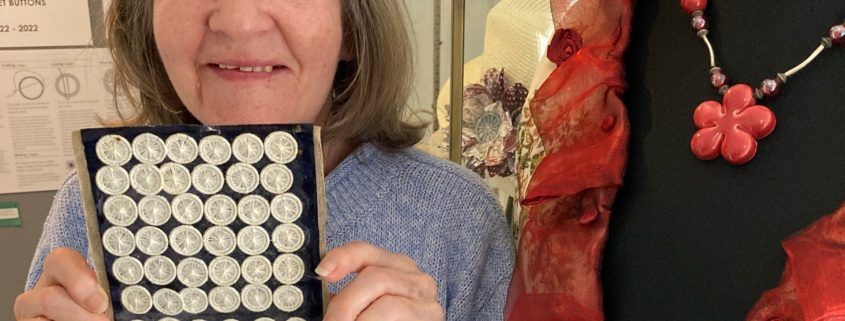400 Years of Dorset Buttons
Shaftesbury can lay claim to being the cradle of the Dorset Button industry. Early buttons were hand-made using sheep’s horn and wool, readily available in North Dorset. In 1622 Abraham Case moved to Shaftesbury and set up the first commercial button making enterprise. Originally from Gloucestershire, he had been a professional soldier in Europe where he had observed French and Flemish button makers at work. On his return he married a local girl from Wardour before settling in Shaftesbury and setting up a workshop. His first buttons (Hightops) were a conical shape made from sheep’s horn, cloth and linen thread.
As demand grew, buttons were made by home-based outworkers who might combine labour on the land with piecework buttony. A skilled buttoner could make up to six dozen (72) buttons a day and earn up to three shillings (15p). This compared very favourably to wages of, perhaps, nine old pence (4p) a day for much more strenuous farm work. A flattened version of the Hightop was preferred for more flexible garments and called the Dorset Knob – possibly the biscuit of the same name resembled it in shape.
By the end of the 17th century, buttony had grown to be an important cottage industry, still controlled by the Case family, while Shaftesbury was noted for its high proportion of pedlars and hawkers. A second depot was opened in Bere Regis, with agencies at Milborne St. Andrew, Sherborne, Poole, Langton Matravers and Tarrant Keyneston. After a disastrous fire at Bere in 1731, a Yorkshireman, John Clayton, was engaged to reorganise the firm. Clayton had an interest in a Birmingham wire manufacturers, which sent wire by horse and cart to Dorset where children were employed as winders, dippers and stringers to produce metal rings by the gross (144). These replaced horn as the base for the many variations of the Singleton and Crosswheel designs. Where smaller and softer buttons were required, as for children’s clothes, the Bird’s Eye was stitched over a thread or fabric base.
Buttons were graded by quality. The finest export grade were mounted on pink cards, domestic quality on dark blue (as held by Sheena above) and the lowest quality on yellow cards. Buttons retailed for between 8d (3p) and three shillings a dozen. The business prospered until the turn of the 18th and 19th centuries, with 4000 employed as outworkers. The mechanisation of button-making in the Victorian Age sounded the death knell of handcrafted Dorset Buttons as a source of reliable employment. The factories of Birmingham became the dominant centres of costume jewellery production. Many hundreds of rural Dorset families, impoverished by the collapse of buttony and agricultural depression in the late 19th century, became economic migrants to Australia, Canada and the USA.
To mark the 400th anniversary of the foundation of the Dorset Button industry, Gold Hill Museum has supplemented its permanent display in Room 5 with temporary exhibits (some on the landing opposite the lift) showcasing modern Dorset Buttons and their various uses. These range from buttons on clothes to earrings, Christmas tree ornaments, brooches and the decoration of bookmarks and lavender bags. There are enormous examples of Dorset Cartwheels and Dreamcatchers. We are grateful for the assistance of Anna McDowell of Henry’s Buttons in staging this Exhibition.
Kits for making your own Dorset Buttons are available in the Museum Shop.
And Basil, Lavender, Poppy, Rocket, Rosemary, and Snowdrop are our Dorset Button Mice. They are hiding in six different display cases throughout the Museum, waiting to be discovered by visitors of all ages.





